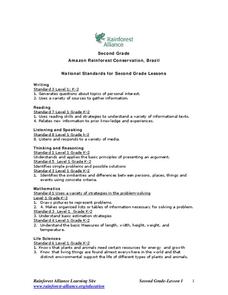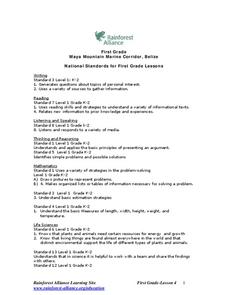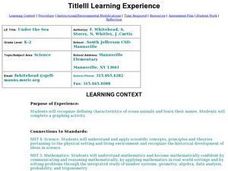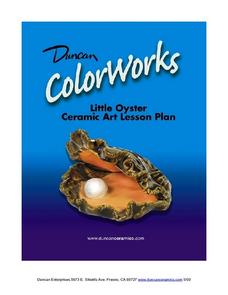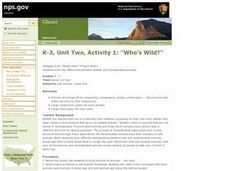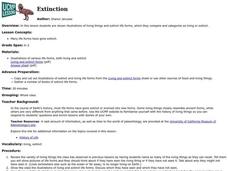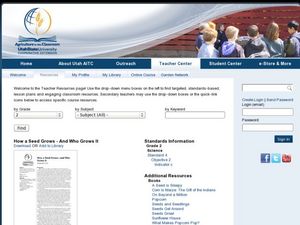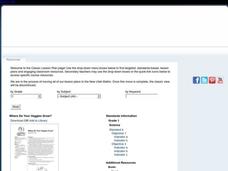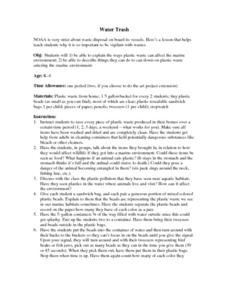Curated OER
The Life Cycle of the Butterfly
Students examine the life of a butterfly. They write a biography from the point of view of a caterpillar using new vocabulary. They use magnifying glasses to examine butterflies and caterpillars.
Curated OER
Amazon Rainforest Conservation, Brazil
Students explore rain forests. In this rain forest lesson, students participate in a "BioBlitz" of their schoolyard, observing and recording every living thing in a designated area. Students visit websites about rain forests...
Curated OER
Who Takes Care of the Maya Forest Corridor?
First graders study the animals in the Maya Forest Reserve. In this conservation lesson, 1st graders create a graph to compare the environment of animals to their own. They design a 3D model of these two environments.
Curated OER
Under the Sea - Ocean Mammals/Fish
Learners explore the similarities and differences between ocean mammals and fish. The characteristics of the life forms observed are placed onto a graph. The classroom becomes the botom of the sea and is explored to gain the required data.
Curated OER
Fred the Fish -- A River Ran Wild
Students apply cause and effect relationships to water pollution in a stream. In this pollution instructional activity students recognize the importance of clean water in their daily lives. Students accompany "Fred the Fish" as he...
Curated OER
Are You One Of Us?
Students discover how to classify things based on their similarities and differences. Students give the characteristics of insects and create a classification list. Given examples of various types of insects, students classify them...
Curated OER
Little Oyster: Ceramic Lesson
Children will love researching and then creating a bottom dwelling mollusk of their own. They watch clips describing the ocean ecosystem and how oysters fit into their environment. Next, they research what oysters eat and how they look....
Curated OER
Different Environments
Students read literature selection, discuss habitat, divide habitats into different categories such as water, soil, and land, list animals that live in each habitat, and describe habitats using descriptive words in vocabulary list.
Curated OER
Birth, Growth, And Development
Students understand that all living things have a life cycle that includes being born, developing into an adult, reproducing, and eventually dying.
Curated OER
Habitat is Home
Students complete a picture to show things found in their homes. For this habitat lesson, students discuss and make a class picture of an animal habitat and its four basic needs. Students sing a song. Students create their...
Curated OER
Meet the Plants
Students examine the difference between living and non-living things. In this living versus non-living lesson, students complete a KWL worksheet and a Living and Non-Living Chart. They examine a variety of plants and non-plants before...
Curated OER
We're All In This Together
Students discover what a coral reef is and the animals that live there. In this ecosystem lesson, students act out a story with ocean organisms. They answer questions that show the interdependency of the sea animals.
Curated OER
Plants and Animals
Students find common needs between plants and animals. In this plants and animals lesson students compare that both plants and animals need food and water. They also find the differences between plant and animal needs.
Curated OER
Get to Know- Insects, Spiders and Others
Students investigate live insects. In this insects and spiders lesson, students work in groups to explore the outdoors and capture insects. Students observe, discuss and record information about the insects they discover. Students...
Curated OER
Observing Plants
Students identify how plants affect the survival of a caterpillar and what plants need to survive. They plant three bean seeds in the three containers, placing two containers at a sunny window and the third one in a dark closet and label...
Curated OER
Who's Wild?
Students explore the differences between animals of the wild and domesticated animals. In this wild animals activity, students understand that tame animals ancestors were once wild. Students illustrate the differences by...
Curated OER
Inside the Egg, Hatching Chickens
Students conduct an egg candling activity to show the life inside a fertile egg. Students discuss the needs the egg has of the hen, as well as similarities and differences between plants and animals. Students complete a life cycle wheel...
Curated OER
Extinction
Students peruse illustrations of living things and extinct life forms, which they compare and categorize as living or extinct.
Curated OER
How a Seed Grows and Who Grows It
First graders explore biology by viewing PowerPoint presentations in class. In this plant life lesson, 1st graders identify the life cycle of a plant and how to properly plant a seed outside. Students view a movie about plant life and...
Curated OER
Where Do Your Veggies Grow?
First graders investigate the origins of vegetables. In this Science lesson, 1st graders identify where fruits and vegetables come from. Students describe how people utilize plants.
Curated OER
Dinosaurs 1: Where Are the Dinosaurs?
Students explore dinosaurs. In this dinosaur identification lesson, students watch video clips for different dinosaurs from the Discovery Kids website. Students discuss the clips with their teacher. Students may then role play the...
Curated OER
Water Trash
Students explain the ways plastic waste can affect the marine environment. They are able to describe things they can do to can down on plastic waste entering the marine environment.
Curated OER
Convening, Creating, and Conventioneering
Students study coelenterates. In this science lesson, students author a story regarding the life cycle of coelenterates following an in depth study of the creatures.
Curated OER
Bivalve Biology
Students place clams into a beaker containing saltwater. They place a small drop of food coloring just above the shell. Students observe the movement of the food coloring. Clams are then placed into clean beakers of saltwater with 24...

